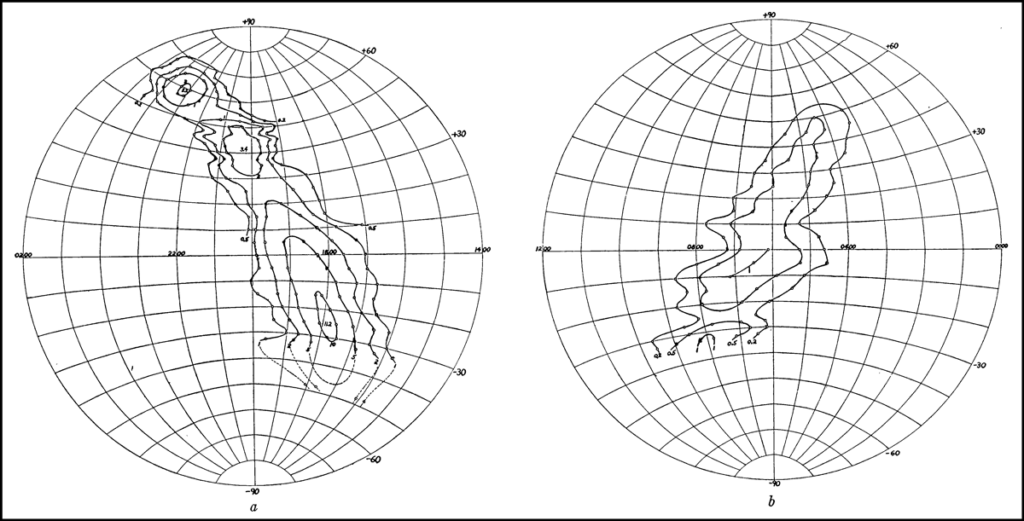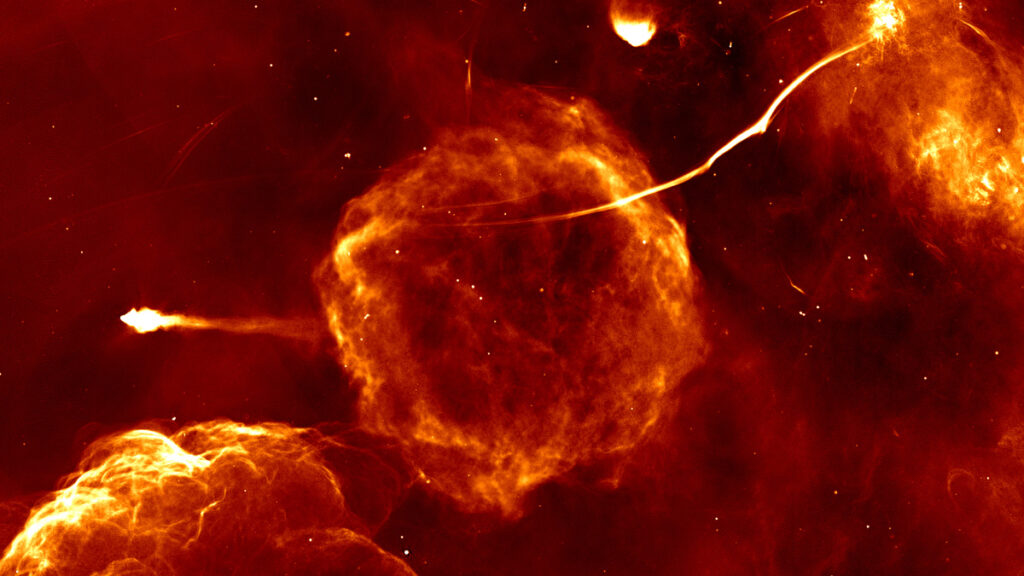“I think it’s fair to say the results exceeded everyone’s expectations.”
Between May and June 2018, the MeerKAT radio telescope observed the center of the Milky Way using 64 antennas located in the Karoo region of South Africa. After more than 200 hours of observations and 3 years of data analysis, the South African Radio Astronomy Observatory (SARAO) released spectacular images of the region near the supermassive black hole in the center of our galaxy, 25,000 light-years from Earth.
Ian Heywood, a senior researcher at the University of Oxford who led the team that analyzed the data, explained that the galactic center was chosen to demonstrate the possibilities of MeerKAT because the region “is a notoriously difficult part of the sky to image at radio wavelengths, because of the very bright emission and complicated structure.… I think it’s fair to say the results exceeded everyone’s expectations.”
From Static to Startling Images
Radio astronomy is still emerging from its infancy. Just 90 years before MeerKAT became operational, radio engineer Karl Jansky built a 30-meter antenna while working for Bell Telephone Laboratories in New Jersey. He had been commissioned to find the cause of static in transatlantic telephone calls—and found that the radio interference came from outer space. At the time, astronomers did not pay much attention to his work. For Heywood, the first radio astronomer who made an impact was Grote Reber, who illustrated the possibilities of radio astronomy by mapping cosmic radio sources in the galaxy in 1968.

“Leaps and bounds” is how Emily Rice, an associate professor at Macaulay Honors College at the City University of New York, described current advancements in radio astronomy. “The angular resolution is so amazing, the sensitivity is so amazing,” she added, “that we can turn [radio frequencies] into actual pictures.”
With new and more powerful radio telescopes, however, there is a need for more efficient ways to process the huge volumes of data, as well as better calibration and imaging algorithms. Observations from MeerKAT to the galactic center produced about 2 terabytes (2,000 gigabytes) of data per day, and there are other observations at MeerKAT that produce even more data, said Fernando Camilo, chief scientist of SARAO. (In comparison, the Hubble Space Telescope produces about 140 gigabytes of data per week.)
“Necessity is the mother of invention…[and] many novel developments in this area are being led by South African scientists,” said Heywood. One of these scientists is Isabella Rammala, a Ph.D. student at the Rhodes Centre for Radio Astronomy Techniques and Technologies at Rhodes University in Makhanda, South Africa. Rammala is interested in identifying pulsar candidates in the galactic center imaged by MeerKAT. “I spent most of my time on my computer writing code,” she explained, “processing the images or cleaning the data…removing things like radio interference and correcting for instrumental effects and sky effects.”

Radio Emissions from Stars and Exoplanets
Radio astronomy offers several technical and practical benefits to scientists. Its observations are not obscured by interstellar gas or dust, sunlight, or anomalies in Earth’s own atmosphere. This means that unlike optical telescopes, radio telescopes can be built at sea level and observations can be made both night and day. For Rammala, studying the universe in multiple wavelengths such as radio, infrared, and gamma ray “gives us somewhat of a complete picture of what is going on.”
Jackie Villadsen is a visiting assistant professor at Vassar College in New York and an astrophysicist who uses radio astronomy to study nearby stars and their interactions with planets. She said observing the universe with different types of wavelengths reveals “vastly different pictures.… Radio waves are good for studying extremes, high-energy processes, and very large objects.”
According to Villadsen, new and more powerful radio telescopes with better imaging capabilities “will help [astronomers] see analogues to the Sun and Jupiter in exoplanetary systems.” For example, coronal mass ejections (CMEs) are fairly easy to detect with radio astronomy. Flares can strip away an atmosphere and bake a planet’s surface, and red dwarf stars, many of which likely have small, rocky planets, have a higher flare rate than the Sun. “Detecting stellar CMEs with radio telescopes will help astronomers determine whether planets around red dwarfs are habitable or friendly to life as we know it,” said Villadsen.
In addition, astronomers hope to detect radio bursts produced by the aurorae of exoplanets, similar to those produced by aurorae on Jupiter. Detecting these radio waves will permit scientists to determine the planet’s magnetic field strength, which “would reveal information about a planet’s interior structure and how well it can hold on to its atmosphere when it’s blasted by material from the star. This might even become a method for detecting new exoplanets,” added Villadsen.
Supporting Local Science
Right now, “it’s something of a golden age for radio astronomy.”
For Rice, “there’s always going to be technological advancements,” but the most important thing is the effects telescopes have in the communities in which they’re located. For example, when MeerKAT made a call for open time observation proposals in 2020, more than a third of the proposals accepted through a dual anonymous review process were from South African researchers.
According to Camilo, around 10% of SARAO’s yearly budget goes to scholarships and grants to support human capital and development—from science projects in a high school in a town near the telescope, to Ph.D. fellowships, to more public support for radio astronomy in South Africa.
Right now, “it’s something of a golden age for radio astronomy,” added Heywood.
—Santiago Flórez (@rflorezsantiago), Science Writer

